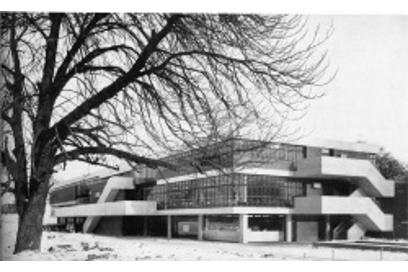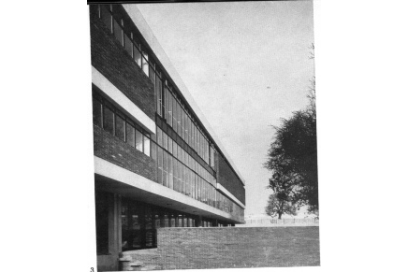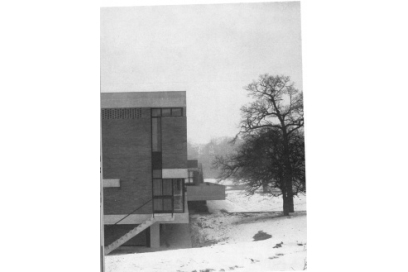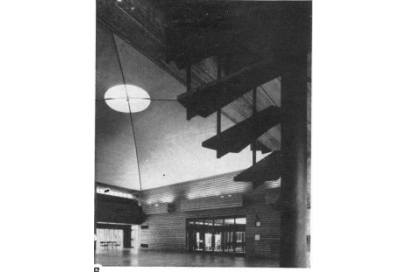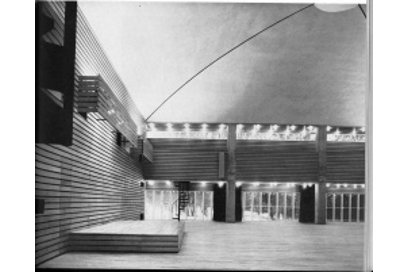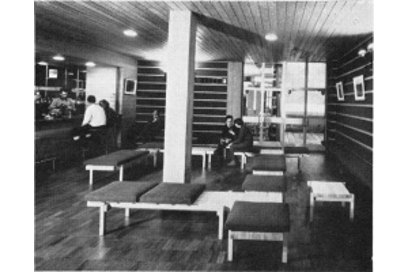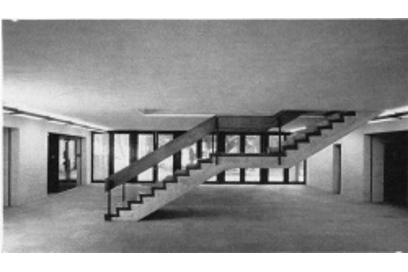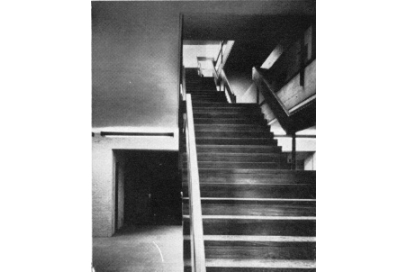Skiff Ahoy and the new Union building!
No, a skiff is not a small boat bobbing on the waves, but a small plastic container of fond Keele memory.
This story provides the opportunity to see the Students' Union as it appeared in 1962. The three interiors were taken by John Samuel (1964) and here is a view of the original "Mississippi steamboat" building.
"I worked on the Students' Union bar, on and off, from 1967 to 1972. Originally, all drinks were served in proper glasses, but skiffs were brought in at some time during my days as a bartender. As far as I recall, 'Skiff' was the brand name of the plastic glasses originally purchased."
Jason Hill (1971)
"Skiffs were brought in after I'd decided to take my shoes off in the ballroom and dance on a broken pint glass... Autumn Term 1972... spent about four weeks on crutches... Yes I was a fresher and yes I was very silly indeed..."
Steve Ellis (1976)
"Skiffs - certainly do remember them. I'm not sure if it's fondly, though, we were mostly interested in getting them filled. We certainly weren't beer snobs. We'd drink the keg beer because it was cheap - and so would today's 'real ale' nuts if there was nothing else. I think they were introduced around 1970-71. I remember the bar staff going around collecting huge columns of them - just like the cricket fans do now. When I arrived at Keele in 1969, Guinness was 1/11 a pint and Tartan Bitter was about 1/6. Later we had Federation Keg - a beer supplied to working men's clubs and that was even cheaper. I think it was only about 11 or 12 pence in 1973."
Peter Varden (1973)
"Until you reminded me I had totally forgotten the word skiff - despite the fact it was a major part of my life at Keele."
David Stovell (1978)
"Skiffs! Well, well! A very important word (and vessel) much used in the 1970s and particularly in the Union and its disco - compulsory in the latter but not the bar. Thus a quote from a 1970s disco doorman: "You're not dancing without your skiff!""
Ashley Howells (1979)
Photo right: The Snack Bar in 1962 by John Samuel
"I think the Skiff moniker derived from a company of that name who made them. I seem to recall seeing it on the bottom of the two or three pints I managed to consume in between library visits."
Phil Pennicott (1979)
"Yes, I remember skiffs well from 1979-83... they kept the beer warmly lovely. Was the beer cloudy or the glass scratched? They retained that essential aniseed taste for weeks after the Pernod promotions evenings! Oh, the luxury of moving into the KRA when doing a PGCE - real glasses (and I mean jugs!) with Pedigree...aah!"
Steve Barks (1982)
"I have a vague memory that 'Skiff' was the brand name for the plastic pots."
Ian Radcliffe (1982)
"Skiffs, yes! I had to explain that one recently in a pub where plastic glasses were being used on match day."
Robyn Bechelet (1986)
"I worked on the bar 1984-86, and a plastic pint glass was a 'skiff'. Is that true to the present day? I'd forgotten all about this, and big nostalgic thanks for stirring that memory."
Hugh Shipman (1986)
Photo below: by Rick Regan (1987) - in the Union
"I remember the skiff'! The word certainly seemed to be prevalent during my time at Keele (1984-87) and I have often used it amongst non-Keele friends. Funny thing is, no-one's ever asked me what I meant, so I always assumed it was pretty universal! Thinking about it though, I've never heard any non-Keelites use the expression, nor have I seen it in writing anywhere. Perhaps it is indeed a unique piece of Keele 'argot'....?"
Liz Walmsley (Delany) (1987)
"Surely whether a brand name or not, "skiff" comes from the Ancient Greek skyphos/skyphoi, which were small drinking cups, two-handled if I remember correctly."
Luisella O'Shea (1990)
"OK – after a quick facebook poll among my friends and removing all the swearwords – Keelites remember them as skiffs but some research by one of my friends (googling "skiff plastic pint") reveals that others do use this to mean the same thing, just not very often. It is not a pure Keele word - though of course there are different quality skiffs - the ultra throwaway ones and the ones that want to masquerade as real glasses just without the sliver of glass in your foot/face potential."
Simone-Davis (1988)
"Plastic pint glasses were still known as 'skiffs' when I was at Keele (1985-88), and come to think of it I don't think I remember hearing them so described anywhere else. A quick web trawl comes up with very little, although the online news site of TCU (Texas Christian University) is called the 'Daily Skiff'. Any connection, I wonder? About the only other Keele-specific term I can remember is PubCirc - the wonkily-printed sheet of useful, irrelevant and bizarre information which appeared under the flat door each week."
Helen Southall (1988)
"Certainly remember the word 'skiff'. Have never heard it used anywhere else, but possibly because once you leave Keele, you rarely drink anywhere that uses plastic glasses." Richard O'Hagan (1989) and later... "Somewhat to my surprise, I learned recently that 'skiff' is also used to refer to the plastic pint pots at Oxford University."
Richard O'Hagan (1989)
"I worked in the SU bar 1991–94 and plastic glasses were skiffs then. I have also not heard this term since leaving the Uni."
Chris Kirby (1995)
"If you look at this blog post, it shows the uses of "skiff" as by no means restricted to Keele! Cheers!"
Simon Sweetman (1966)
"For the record, the plastic glasses were still called Skiffs at the turn of the Millennium when I worked there."
Chris Durham (2001)
Not quite a skiff story but close enough:
"A few years ago, I met Chris "Kit" Renwick at a teachers' conference. He said, "I want to ask you an important question, Pete. Did I have a good time at Keele, or is it just nostalgia?" Chris belonged to a different circle than me, but they were always in the Union, by the left-hand door, rarely opened, into the ballroom. And since we were always there too, they knew us. My reply was something like this: "Put it this way, Chris, every time I saw you, you had a full pint and were laughing your head off." Chris said: "Pete, that's good enough for me. You've put my mind at rest." Isn't it amazing what one can find at the bottom of a beer glass?"
Pete Varden (1973)
"When I was a student at Keele the Students' Union had only one small and usually very over-crowded bar, referred to as "the Union bar". In the 1970s the cafe area (which was much bigger than the bar) was converted into a bar as part of the plan to build an extension of the building. When the extension was opened, in June 1976, the bar was named the Allright Bar, in commemoration of George Allright, the union's long-serving and much-appreciated chief porter."
Robert Smith (1974)
Rick Regan (Study Abroad 1986-1987 USA) captures the spirit of the Union Ballroom
"The little bar by the balcony and attached to the ballroom was called Sam's bar. I thought the Allright bar and the Nelson Mandela bar were the same but my mind could be playing tricks on me."
Ian Harris (1984)
"During my period this side bar was called the Allright Bar. No one seemed to know where that name came from either..."
Nick "Vic Lemon" London (1992)
"Could 'Sam' refer to Sammy Finer?"
John D Smith (1957)
"I originally thought Sam was a Sneyd but then I remembered that they named Sam's bar after a long serving member of staff of the Union."
Matt Woods (1996)
"I believe Sam's bar used to be called Baldwin's Bar after a chap who used to used to hang out at the Union most of the time - Neil Baldwin? I think it was renamed Sam's Bar around 1996 but the reason escapes me. It may have been in honour of someone who gave many years of service to the Union as grounds staff, cleaner, or some such, but it didn't seem that big a deal at the time."
Thom Craigen (1997)
"It was named Sam's bar after I left. Sam wasn't a bar manager (the bar manager was called Tommy and the assistant Bar Manager whom I think took over was called Ralph I think (he lived in a flat at the top of the SU building). Sam was a lovely man whom I cannot think of a bad word to say about, and he was the (Head?) Cleaner. He was a redhead, and I remember him always seeming to wear blue. He well deserved to have a bar named after him… unlike the aforementioned bar managers."
Anna Summerskill (1981)
"Now all you have to do is work out who was a red-headed cleaner at the SU in the 1980s! In my own Committee's SU Handbook (1981) they name the three Union Bars as the Main Bar, the Ballroom Bar and the Allright Bar so I'd guess it was renamed in 1982 or 1983. I think maybe there was a refurbishment involved and it reopened with the new name. That may have been something to do with the Leisure Games deal too but I really can't remember."
Peter Roberts (1983)
"The Allright bar was named after George Allright who was connected with the SU in some way, died and the bar was named in his honour. In 1990/91 year a group of students took a motion to a UGM (Union General Meeting) to rename it (I believe to 'Book and Candle'). Unfortunately they entitled their motion "(deleted) from (deleted)" and the previous year's Deputy President (Cathy Gattis?) was in attendance. She explained the provenance of the name; I believe she also explained why the bar was named in memory of George Allright but there my memory, and the twenty year chasm of time, fail me, and expressed some opinions about the motion and the people who proposed it."
Stephen Booth (1993)
"It was called the Allright Bar after George Allright who was the Student Union Porter for many years. George was a great character - always smiling and well known to everyone who used the SU. He was very skilled at diffusing any trouble which he dealt with calmly and a clear determination that it was going to stop immediately. As SU President (1970/1) I always knew I could rely on George to deal with any problems in the building. I think he retired in the 1970s and I even have a vague recollection of attending his retirement party."
Bob Stow (1972)
"From what I've been able to find out - the bar which is now known as Blueprint was for a long time called Sam's Bar (named after a Union staff member), before briefly becoming known as Bar Dink, and then reverting back to being Sam's Bar (then Blueprint). The Bar on the ground floor was originally called BJ's when it was opened in 1993, before becoming Barista. There was reference to a Baldwin's Bar, but not for long and may not even have been official. However, this bar no longer exists, with ASK (Advice and Support at Keele) now located there and the ground floor being an alcohol free area. What is now the Scruffy Squirrel was the Mandela Bar in the late 80's, and had a number of names after that - Main Bar, Gallery and then Lounge. Prior to K2 being built, there was a bar called the Allright Bar (also named after a Union staff member), and there was a bar at the bottom of K2 when it first opened called the Sports bar. As for renaming/(re)creating one of the bars as a Baldwin's Bar, I'm sure it's something the incoming elected officer team would be happy to consider and see if it's something students want to do."
Bolu Oyewale (2014), Keele SU President, 2014-2015
The New Union Building was opened in 1962. The foundation stone was laid by HM the Queen in the presence of HRH the Princess Margaret, President of the University College of North Staffordshire, on 2nd May 1961. The Union President was Colin Thomas and the Vice-President Jocelyn Ryder-Smith. The Architects were Stillman and Eastwick-Field.
"Paul Jennings, the once-popular but probably now-forgotten humourist, speaking in the Union ballroom in the mid-60s, described it (the ballroom) as "looking like a Swiss chalet, turned inside-out". At that date, the off-white fabric of the ballroom ceiling had a slightly sparkly, ice-like texture, that it may since have lost, which contributed to the description." Roger Mortimer (1967)
Photos below: The Ballroom and below right The Lounge in 1962 by John Samuel. All that beautiful pine!
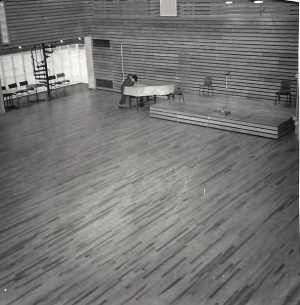
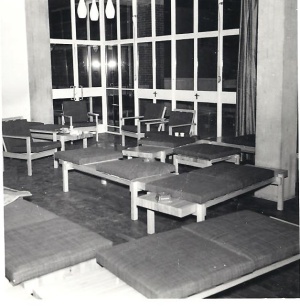
"In the 1950s, the Students' Union was housed in Nissen huts and connecting buildings, roughly on the site now occupied by the Chapel. One larger area served as a general meeting place and the venue for union debates, film shows, weekly dances and other functions. It was served by a snack bar, with a kitchen. A second smaller area served as a common room and a meeting place for smaller groups.
The Union Committee was elected annually and, from memory, consisted of the President (always male), Vice-President (female), Secretary, Treasurer, Chairman of the Catering & Buildings Committee, the Chairman of the Social Committee and the National Union of Students representative. All were full-time students: there were no secondments or sabbaticals in those days. Mostly, they were drawn from the 3rd year of then then-compulsory four-year course. The elections were conducted by simple first-past-the-post ballot. There was no public campaigning, no manifestos and no hustings. As everybody knew everybody, this seemed unnecessary, although certain trends appeared. For example, the Christian group seemed to align with like-minded candidates: the Student Christian Movement and, to a lesser extent, the evangelical Christian Union, did well in the 1956 elections, whereas more 'secular' candidates had been more prominent in the previous year.
In 1955, I was elected chairman of the Social Committee. I held office, unusually, in my second year, partly, I think, because I had, as a fresher, been useful in running the bar, having had a little experience of the retail licenced trade as a holiday assistant to my father, who was the manager of a wine merchant's shop. This was the kingdom of the blind!
The office support for the Union consisted of one jovial middle-aged gentleman, called Mr Boulton, (I don't think I ever knew his first name). He occupied the one-room office, where he typed the correspondence and offered friendly advice and support to the elected officers. The Catering and Buildings Committee was served by a husband and wife partnership, who looked after the premises and ran the snack bar. In 1956, Jim Roberts was the man in charge and a very valuable asset. One sensed, however, that he was not always happy with the wilder activities of students and he subsequently moved to be caretaker of the newly built Walter Moberly Hall. He was succeeded by Ron Hill and his wife, who served for many years and were remembered with great affection.
Entertainment largely consisted of what students organised for themselves. Going off-campus required both effort and expense. In those days, buses did not run through the campus and waiting to go into Newcastle, often in wind and rain, at the bus stop on the main road was not an attractive option. Persuading the bus company to build a bus shelter was one of the achievements of my time at Keele. A range of student societies arranged meetings with visiting speakers and the Students' Union looked after the social side. One should remember that no one possessed a television set and transistor radios had yet to come on the scene. The radio in the union common room was popular, never more so than when "The Goon Show" attracted a big audience. The main effort of the Social Committee was to arrange what was always called a Hop on Saturday evening, alternating fortnightly with a live local hired band and what was later to be known as a disco. Ingenious themes were devised for different hops: the Nissen hut was very adaptable and appeared in many guises, ranging from a sea cave to an underground station. There was great scope for creativity and no real risk of damaging the building. It was during this period that the music moved on from waltzes, foxtrots and quicksteps to skiffle and rock and the committee purchased the necessary records.
And, of course, there had to be a bar! It might come as a shock to later generations to learn that, in the fifties, the Students' Union did not have a bar. There was no space for one in the buildings and the Catering & Building Committee would have nothing to do with one anyway. It was left to the Social Committee to provide a bar on Saturday nights and at any other event for which it might be worthwhile to do so. This was simply done by setting up a row of tables, bringing out supplies from the store room, lining up the glasses and putting up a row of optics, all done by a sub-group of the Social Committee, recruited to act as bar staff and washers-up. When 'Time' was called, it all had to be packed away again and the area left clean and tidy. Because it was not a fixed venue, it was not possible to serve draught beer. At least it wasn't until the red revolution occurred during my tenure as chairman. One of my duties was to travel down to Newcastle to visit the wholesaler who supplied the bar. I have forgotten the name of the company, but I recall their Dickensian office, where I was plied with a glass of sherry to encourage me to put in good order. It was on one such visit that I was introduced to a new invention, a wooden cabinet on castors which housed a metal keg, a gas cylinder and sundry pipes. On the front was a tap and a drip tray and the tap, when turned on, let out a stream of beer. The was Watney's Red Barrel, in later years to be damned by CAMRA, but hailed in 1956 as the great break-through. Needless to say, this innovation was greeted at Keele, by barmen and customers alike with enthusiasm and the technique of connecting up the pipes was swiftly mastered. Running the bar was the only contentious issue which I can recall from my year in office. As already indicated, the bar was run by student volunteers and a very loyal bunch they were. They worked hard and it was thirsty work. It was understood that, should they feel in need of refreshment during their labours, it was reasonable to have a beer 'on the house' and it was up to the leading barman to see that this concession was not abused. With regular stock checks and comparison with takings, it would, in any case, be evident if anything was seriously amiss.
This approach was challenged at a Union meeting by John Golding, (not a volunteer barman), who was to become a trade union official and later an MP. His case was based more on alleged corruption than on fair shares for the workers and I was able to defend the position successfully. The pressure for change, however, did not go away and, in the following year, my successor, the Australian Mike Steele, introduced payments for bar staff. I never discovered whether this boosted profits or not.
The old Students' Union buildings were remembered with affection by all those who passed many happy hours in them, but, in my final year, we were consulted by the architects about the proposed design for a new building which was to be located where the much enlarged 21st century Union now stands, like the old one, at the heart of the University campus."
John Sutton, Class of 1958
"Here is a full front view of the Mississippi Steamboat Union Building. which is a reprint from a postcard sold in the Students' Union shop at that time. There is no publisher's name on the reverse, just the inscription 'Students' Union, University of Keele' with the reference number PT17182. The dome of the ballroom is clearly visible at the far end. The architect was very proud of that. No vehicles were allowed on the wide paved area leading down to the main doors, on the left hand side of the building. Deliveries to the shop had to be made through the designated rear entrance on the other side of the building. Indeed a vehicle is partially visible there. You may then well ask, What is that car on the paving? I can tell you that it was a Ford Zephyr car (a big one at the time), registration no 88WEH and it belonged to Charlie Wainwright, the Chief Porter and Head of Security. He was a former police officer and a law unto himself. He gave himself leave to park his car there! In the smaller photo at the top of this page, one of the vehicles in the front is a Morris 1000 shooting brake. They had wooden frames on the outside panels. The Assistant Secretary of the Students' Union in 1962/63 was Maureen Ritchie (1964). She owned one of the said vehicles. There is picture from his time at Keele in Mike Mansfield (1964)'s autobiography. It shows him and Maureen Ritchie getting up to some high jinks. Sadly she is now deceased. I took the internal photo of the ballroom (above) from the balcony above the door. I wanted to show something of the scale of the place, so I persuaded my friend and fellow student, Pete Smith (1966) to lean on the grand piano. He can be seen in the photo. Just by coincidence, Pete and I met on the Hole in the Wall soccer pitch in Keele in October 1961 and are still good friends nearly 50 years later. His wife, then Hilary Deere, also graduated from Keele in 1966."
John Samuel (1962)
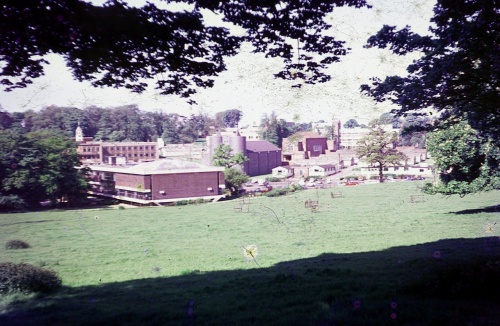 This photo (right) was taken by Malcolm Payne (1969) from Observatory Hill - the Union and its dome and more of the campus is visible from the opposite direction to John Samuels' shot. The grey Chapel has now been built (1965) with the Walter Moberly Building beyond. The Tawney Building is obscured by the tree on the right.
This photo (right) was taken by Malcolm Payne (1969) from Observatory Hill - the Union and its dome and more of the campus is visible from the opposite direction to John Samuels' shot. The grey Chapel has now been built (1965) with the Walter Moberly Building beyond. The Tawney Building is obscured by the tree on the right.
The Administration Huts can be seen to the right of the Chapel - where there is now a lawn of flowering cherry trees.
The following eight photographs appear with the permission of "The Architectural Review" 1963 v133. The building was featured in 1963 with descriptions of the materials and floor plans. The Architects were Stillman and Eastwick-Field. The beautiful, airy, open pine staircase was boxed in many years later for reasons of Health & Safety, making the light, bright interior darker and boxier, but it should be restored to its least some of its early glory during the planned ground-floor refurbishment of 2012-2013. But who authorised the light pine panelling of the Ballroom to be painted black?
Published with permission.


